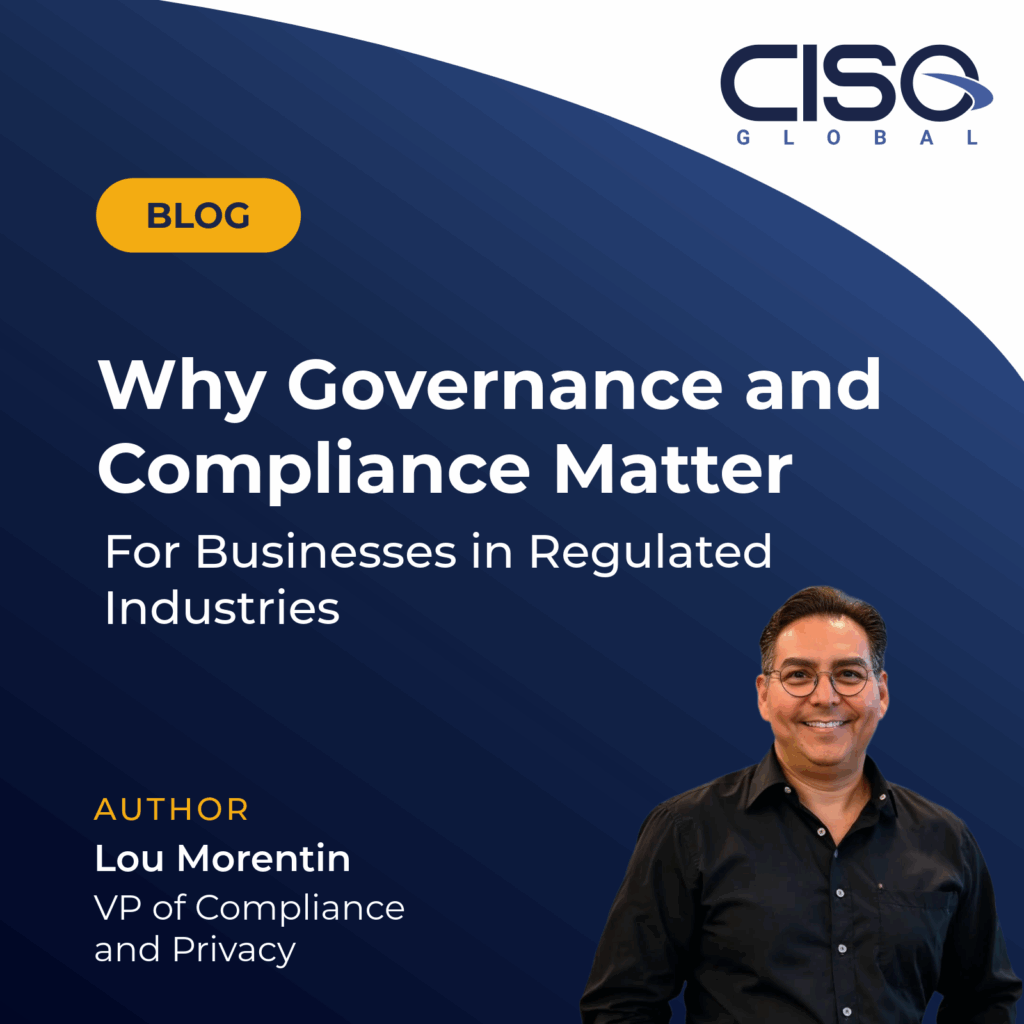Why Governance and Compliance Are Essential for Businesses in Regulated Industries
Lou Morentin, VP of Compliance & Privacy

Effective governance and compliance frameworks empower organizations to manage staff with clarity and consistency.
As regulations grow more complex, governance and compliance are not optional but foundational pillars of a resilient, trustworthy, and well-managed organization. For businesses operating in regulated industries such as finance, healthcare, energy, and cybersecurity, the stakes are even higher. Regulatory scrutiny, data protection mandates, and ethical expectations demand that organizations embed governance and compliance into their operational DNA.
Governance: Structuring Control with Purpose
Governance provides the structural backbone that aligns an organization’s controls with its business goals and obligations. It ensures that policies and standards are developed and implemented to support operational integrity and strategic alignment. This includes defining roles, responsibilities, and escalation paths, ensuring that every employee understands their part in maintaining compliance and operational discipline.
A well-governed organization fosters accountability. Clear policy ownership, version control, and regular reviews help maintain clarity and consistency across all internal policies. Governance also enables organizations to respond swiftly to regulatory changes, market shifts, and emerging risks. By establishing a framework for decision-making and oversight, governance empowers leadership to steer the organization with confidence and transparency.
Compliance: The Operational Enforcer
Compliance is the mechanism that ensures governance is not just theoretical. It translates policies into action by overseeing control implementation, conducting audits, and validating adherence to statutory, regulatory, and contractual obligations. This operational rigor is especially critical in managing sensitive data and protecting stakeholder trust.
For example, in industries governed by HIPAA, GDPR, or CCPA, compliance involves implementing technical safeguards, maintaining audit logs, and conducting regular risk assessments. Organizations must also develop breach notification procedures that meet regulatory timing requirements and ensure that privacy rights are respected.
Compliance is not just about avoiding penalties, it’s about building a culture of integrity. When employees understand the importance of compliance and see it modeled by leadership, they are more likely to follow procedures, report violations, and protect regulated data appropriately. This cultural shift transforms compliance from a burden into a strategic asset.
The Business Case for Governance and Compliance
Beyond regulatory obligations, governance and compliance offer tangible business benefits. They reduce the risk of financial loss, reputational damage, and operational disruption. They also enhance customer loyalty, attract investors, and improve employee morale.
Multiple studies show that the costs for managing regulatory compliance can exceed 3% of wages. This number seems high, the cost is critical in avoiding violations, avoiding reputational damage and ensuring continued operations.
Moreover, governance and compliance support innovation. When organizations have clear policies and controls, they can experiment and scale with confidence. They can enter new markets, adopt emerging technologies, and form strategic partnerships without compromising their integrity or exposing themselves to undue risk.
Managing Staff Through Governance and Compliance
Effective governance and compliance frameworks empower organizations to manage staff with clarity and consistency. They define expectations, provide training, and establish feedback loops that reinforce desired behaviors. This is especially important in regulated industries, where employee actions can have significant legal, reputational and financial implications.
For instance, compliance training ensures that staff understand how to handle sensitive data, respond to incidents, and report violations. Governance structures clarify who is responsible for what, reducing ambiguity and enhancing collaboration. Together, these frameworks create a workplace culture that values transparency, accountability, and continuous improvement.
Conclusion
In regulated industries, governance and compliance are not just operational necessities, they are strategic imperatives. They protect organizations from risk, enable growth, and build trust with stakeholders. By investing in robust governance structures and proactive compliance programs, businesses can navigate complexity with confidence and position themselves for long-term success.
Whether you’re a compliance officer, risk manager, or executive leader, the message is clear: governance and compliance are your allies in building a resilient and ethical organization.